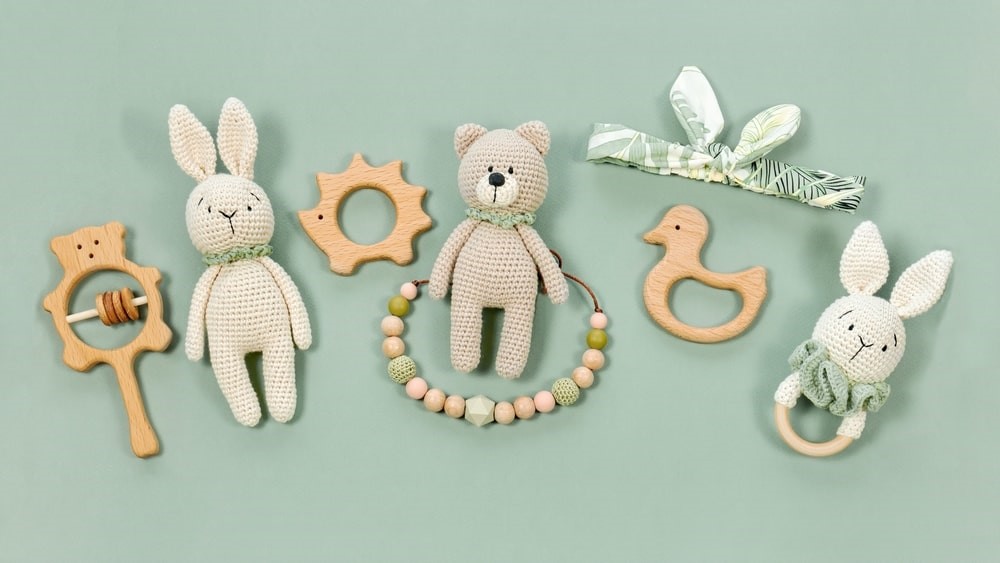
Teething happens when a baby’s teeth start to appear through their gums. The development process typically starts around six months of age but can also begin as early as three months. As a baby’s teeth push through their gums, they may experience discomfort and pain, leading to fussiness, drooling, and difficulty sleeping.
Fortunately, there are ways to reduce their discomfort through teething toys. But before you run to your local store, let’s talk about the best baby teethers to get for your kids and their pros and cons.
What Are Teething Toys?
Teething toys are designed to relieve the pain from sore gums by chewing on them. Teething toys are also known as chew toys which help teething babies. When babies enter their teething phase, their first set of teeth begins to emerge, which causes sore gums that give them pain and irritation.
Teething toys comes in different textures, sizes, and shapes. You can choose between rubber, silicone, plastic, fabric, or wood material. Other teething toys also have cooling and numbing features for teething relief. Make sure to get the age-appropriate teething toy to maximize its effectiveness.
When Should Parents Use Teething Toys for Babies?
There are observable signs to look for that indicate if your kids are starting with their teething.
- During teething, babies produce more saliva, which leads to more drooling.
- Little kids tend to chew and bite on things they get a hand on when they start teething. It can be their fingers, toys, or even furniture.
- Teething can be uncomfortable for your kids, so you can notice they cry often and fuss more than usual.
- You can visibly see their swollen gums, and its tender to the touch.
- Other kids will show disinterest in eating. Always track if they are eating less than usual.
However, some kids will show no teething symptoms at all. If you suspect your kids are starting their teething phase, give them a chew toy to try on.

3 of the Best Teething Toys for Babies
There are several types of baby teether toys. Let’s evaluate each teether’s benefits and downsides for you to choose which one to buy for your kids.
Silicone Teethers
Silicone teethers are popular baby toys designed to help soothe infant teething discomfort. These teethers are made from soft, flexible, and non-toxic silicone material safe for babies to chew on. They come in various shapes, sizes, and colors, including animal designs, fruit shapes, and geometric patterns, to appeal to parents and babies.
PROS
- Made from flexible and soft silicone, which is gentle in your baby’s mouth.
- Produced from food-grade silicone, free from BPA and proven non-toxic.
- Easy to clean and sanitize, and it’s also dishwasher safe.
- You can place them inside the freezer to cool and get more relief from teething discomfort.
- The bright and interesting shapes of the teether promote hand-eye coordination and sensory abilities.
CONS
- Not as durable compared to other teething toy materials.
- Not suitable for severe teething pain.
- It can stain and retain certain flavors and odors when not washed properly.
- Some kids don’t like the texture of silicone teethers.
- Silicone teething toys are more expensive compared to other types.
Rubber Teethers
Rubber teethers are a popular alternative for parents looking for safe and effective ways to relieve their baby’ teething discomfort. Made from soft, chewable rubber, these teethers are gentle on a baby’s delicate gums and provide a satisfying sensation for little ones experiencing the discomfort and pain of teething.
PROS
- In general, rubber teethers are safe for your kids. These are produced from non-toxic materials and are not a choking threat for youngsters.
- The highly chewable material provides a soothing sensation for your kid’s hurting gums.
- Many rubber teethers are made with varied textures, shapes, and colors that can assist in stimulating a baby’s senses and boosting their cognitive development.
CONS
- Rubber teethers can wear down over time, reducing their effectiveness and potentially posing a hazard if small pieces break off.
- Some kids have allergic reactions to rubber. Know your kid’s allergies before giving them rubber teethers.
- Some rubber teethers may have a distinct taste or odor that some babies may find unpleasant.
Wooden Teethers
Wooden teethers are a popular alternative for parents looking for safe and natural teething treatments for their baby. Made from high-quality, untreated wood, these teethers provide a safe and durable option for infants to chew on while teething.
The smooth texture of the wood is gentle on their sensitive gums, and the natural material provides a tactile experience for the baby, helping to soothe and comfort them during this uncomfortable stage.
PROS
- Wooden teethers are made from natural materials and are free from harmful chemicals, making them safe for babies to chew on.
- Wood is a sturdy material that can withstand the pressure of babies’ chewing, making wooden teethers long-lasting.
- Wooden teethers have natural anti-bacterial properties to prevent bacteria growth and infection among babies.
- These teethers don’t have small parts that can break off and choke your babies.
CONS
- Among the teething toys, wood is the hardest material and may not be suitable for babies with sensitive gums.
- Wooden teethers are high-maintenance chew toys. They should be adequately maintained to prevent splinters that could bruise and hurt your baby’s mouth.
- Wood can absorb moisture and, when not dried properly, can cause mold to develop.
Pain-Relieving Techniques for Teething Babies
There are several ways you help with your baby’s discomfort. Teething toys is a great tool, but sometimes it’s not enough. Here are other pain-relieving techniques you can do for your kid’s aching gums.
- You can give cold objects to your kids. For example, you can give a damp washcloth placed in the refrigerator to add a numbing effect. Homemade ice pops or even ice cream can also help with their pain.
- You can use your finger to massage tender gums to help with their teething pain. Make sure your fingertips are hygienic to avoid sickness.
- You can use distractions to take their mind off their discomfort. You can maximize playing, singing, or any activity that can entertain your kids.
- You can apply over-the-counter teething gels for their pain. Before giving it to your kids, make sure to speak with a doctor.
- Natural remedies such as chamomile tea or ginger root can help with teething discomfort and reduce inflammation from sore gums.
- Teething is very exhausting for babies. Ensure you give them enough rest and sleep so they are less irritable.

Get the Best Baby Teething Toys Only at Ashtonbee
If you’re looking for safe, effective, and affordable teething toys, then Ashtonbee has them! It’s FDA-approved, made from food-grade silicone, and is BPA-, Lead-, PVC-, and Phthalate-free. The teething toy has an easy grip handle for kids to hold them easily, and the silicone beads are different textures to relieve the baby’s teething pain.
Our teething chew toy is available at a low price of $14.99 and comes in a pack of four. Also, don’t forget to browse our wide collection of baby essentials for more premium items. Shop with us today!



